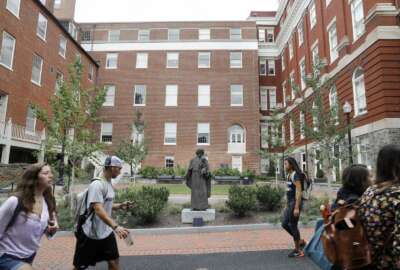
Now hiring at DHS: Resilient critical thinkers ready for the next pandemic
Artificial intelligence, cybersecurity and other technical skills are important, but the last year has underscored the importance of recruiting, retaining and...
The Department of Homeland Security is rethinking and reshaping its workforce training and learning strategy, as the pandemic, like most everything else, upended the way its employees operate and prepare for future national and global events.
Artificial intelligence, cybersecurity and other technical skills are important, but the last year has underscored the importance of recruiting, retaining and training a DHS workforce that can easily adapt to change, department leaders said last week at the DHS Centers of Excellence Summit, hosted by George Mason University.
“It’s such a dynamic environment; things are changing all the time,” said Leann Pask, assistant director for the human performance branch at Customs and Border Protection’s Field Operations Academy. “From a technical skills perspective, we need everything from scientists to law enforcement, but we really are looking at those soft skills that are our cornerstone and that will help us to adapt regardless of what’s going on. Things are changing [more quickly] than we can even train on them.”
It’s why CBP expanded its employee support programs and chaplain program during the pandemic, Pask said. Employee resiliency has always been a priority for the department, but it’s taken on new meaning in the last year.
“Our current and our future employees need to be absolute critical thinkers,” said Clothilda Taylor, the department’s chief learning and engagement officer. “They need to be resilient. This is really what we’re going after. [They need to be] change-ready and understand data analytics.”
It’s these kind of skills that DHS is looking for as it hires new employees — and assesses the skills and training needs of its current workforce.
The Transportation Security Administration is trying to hire 6,000 new officers by this summer.
“That is really another piece that we’re looking for — people who can innovate, who can think of different ways to do things,” said Kim Hutchinson, TSA’s chief learning officer. “This year has proven we’ve had to shift in ways we never really imagined. I never thought I’d create a training program on how to wear a mask, or how to wear a face shield or how to operate in a pandemic. These are really significant changes.”
FEMA conducted a training needs analysis last year and found opportunities to improve employees’ digital literacy skills.
“Are there opportunities for artificial intelligence and for machine learning? What are our folks in our chief technology office doing and how can we integrate that into learning? We just stood up a community of practice that’s looking at technology within FEMA to help foster that connection within our agency,” said Wendy Walsh, the agency’s acting chief learning officer.
As DHS leans into training that’s designed to improve employee resiliency, communication and digital literacy skills, it’s also considering new ways to offer those courses.
Taylor said the department is evaluating what kinds of online training platforms and classes worked during the pandemic and which ones didn’t.
“We live and breathe training, and we sort of all believed it needs to be in person,” she said. “There are still aspects of that, but I also am a much bigger believer now that there’s so much more that we can do virtually.”
At TSA’s training centers, employees started virtual book clubs where they read about resiliency and leadership, Hutchinson said.
“It sounds hokey, but it was a great way to get people to come back together,” she said. “It’s outside your day-to-day job, but it has that side benefit of keeping everybody connected.”
The agency also launched a new program where employees can sign up to have virtual coffee with Hutchinson and other leaders at TSA’s three training centers. A random generator chooses one person to participate each week. Hutchinson said it’s one of several ways TSA has changed its methods of communication with employees during the pandemic.
Like several agencies, the department expanded work hours and implemented other workplace flexibilities during the pandemic, which Taylor said have bonded employees at DHS headquarters and instilled a sense of loyalty and trust.
“People needed to understand how important they are to us,” she said. “It’s not just always about the work that they do, but it’s about them as a human. We decided very early on that we were going to be very flexible. We found ourselves making sure that our employees understood the flexibility was there, to the point where we don’t care if you work at midnight. Whatever you need to do, just work it out with you and your family.”
Copyright © 2025 Federal News Network. All rights reserved. This website is not intended for users located within the European Economic Area.
Nicole Ogrysko is a reporter for Federal News Network focusing on the federal workforce and federal pay and benefits.
Follow @nogryskoWFED




